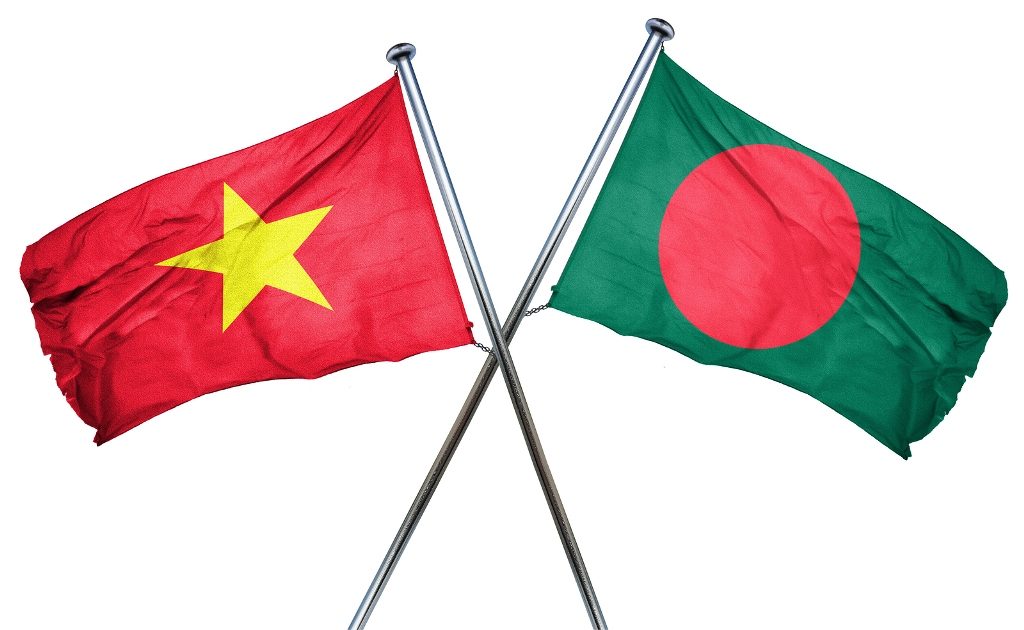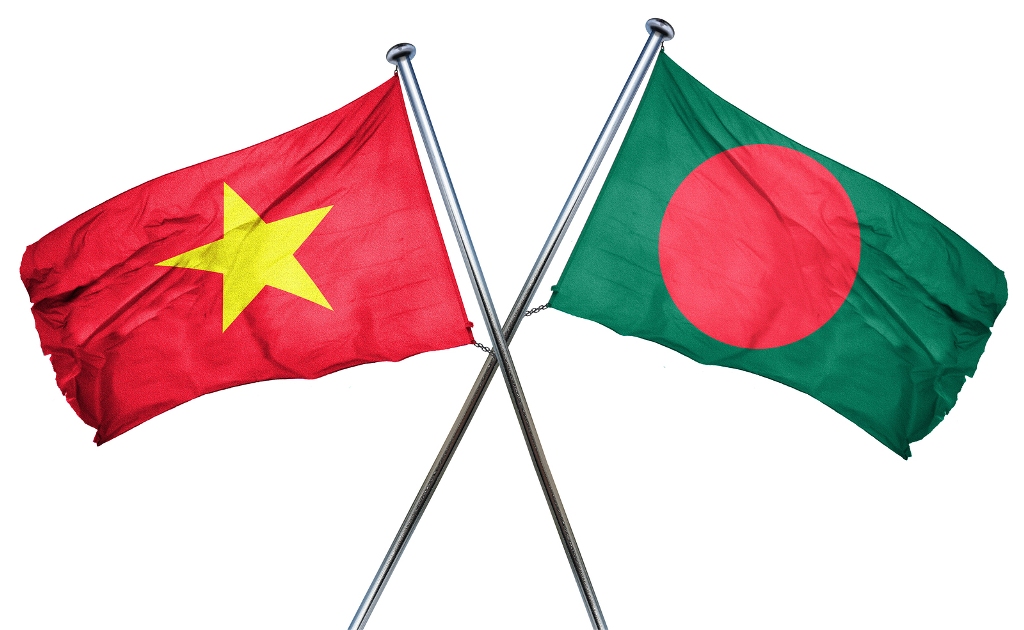Enamul Hafiz Latifee writes,
Bangladesh has demonstrated staggering economic performance over the last decade spotting 6.76 percent annual average GDP growth and now paving towards double-digit growth just after achieving 8.13 percent GDP growth in the Fiscal Year (FY) 2018-19 by registering GDP of US$ 302.43 billion, thanks to the government reformative steps to diversify industrialization and facilitate international trade and commerce. The sustained economic growth is now leading Bangladesh to become a developing country by 2024 and developed country by 2041.
On the other side, Vietnam’s US$ 260.30 billion economy is forecasted to grow to 6.5 percent on average in 2019-23 from 5.9 percent in 2012-16. Exports are expected to fasten economic activity, adjoined by the influx of foreign direct investment (FDI). According to Goldman Sachs, Vietnam is poised to become the world’s 21st largest economy by 2025.

Bangladesh and Vietnam, both countries are on the verge of further economic expansions in terms of export-import, investment and economic integration. This common interest between Bangladesh and Vietnam should render closer bilateral economic ties that would enable receiving the goals on or before the targeted timeline.
Bilateral Trade Scenario
The export earnings of Bangladesh from Vietnam amounted to US$ 53.47 million in FY 2018-19. During the period, Top 10 exporting products covering 54.81 percent of the exports were fresh, chilled, frozen, salted Guts, Bladders and Stomachs of animals; Leather of animals without hair; Single Yarn of Jute or of other Textile based Fibers; Sacks and Bags of Jute; Slag, Dross, etc. from the manufacture of Iron or Steel; Sesame Seeds; Medicaments of Mixed or Unmixed Products; Raw Jute and T-Shirts, Vest of Cotton- knitted.
In FY 2017-18, imports of Bangladesh from Vietnam reached US$ 594.69 million. The Top 10 imported items by Bangladesh from Vietnam were Cement and Cement Clinkers; Rice; Telephone Sets and Cellular Phones; Pebbles, Stones and Gravel; Cotton Yarn other than Sewing Thread; Synthetic Filament Yarn; Leather further prepared after tanning or crusting; Structures and Parts of Structures; Woven Fabrics of Synthetic Filament Yarn; Natural Rubber and similar Natural Gums.
Air Connectivity: Direct flights to start
There is no direct air-flight between Bangladesh and Vietnam. As a result, it takes more than 17 hours to travel from Bangladesh to Vietnam and vice versa, though the air distance between these two countries is 2,165 kilometers.
By realizing this criticality of air connectivity, while meeting Bangladesh Prime Minister Sheikh Hasina last year on 26 April 2018 at Intercontinental Sydney Hotel in Australia, Honourable Vietnam Vice-President Dang Thi Ngoc Thinh expressed her country’s keen interest to establish direct air connectivity with Bangladesh. This would cut down the average flight-time from 17 hours to 4 hours, saving around 13 hours that would surely encourage business entrepreneurs and industrialists to pay frequent visits to both of the countries with a view to expanding trade, building up direct business relations and making investments.
Issues with Letter of Credit (L/C) Opening: Finding the best alternative
Vietnam has regulatory protection against the risk of payment for export against contracts or open account so that importers are not likely to open L/Cs and bear additional bank charges, however, the case is pretty different in Bangladesh as regulatory protection to the alternatives of L/Cs is quite inadequate. As this intra-country banking difference is significantly hurting bilateral trade so that either Bangladesh may consider pursuing Vietnamese Govt. to encourage it’s importers to open L/Cs while importing from Bangladesh and take special awareness programs on that, or Bangladesh may introduce other alternatives to L/Cs backed by newer regulatory framework to protect exporters.
Issues with Visa Application: Easing the application process
Bangladeshi business people face a significant challenge in applying for Vietnamese multiple-entry business visa. The visa application requires submitting the invitation letter from Vietnamese company and also No Objection Certificate (NOC) from the Ministry of Home Affairs of Vietnam that is a real hurdle for business people to obtain.
Taking under consideration, the existing required visa application documents and processes to follow for multiple entry business visa, it is recommended that Bangladesh and Vietnam should provide visa exemption to each other’s citizens for 30 days and for more than 30 days stay- multiple entry business visas, the requirement of NOC from Ministry of Home Affairs of Vietnam should be waived.
Attracting Vietnamese Industrialists to Relocate Factories and BPMO businesses
Bangladesh received a record US$ 3.61 billion in FY 2018-19 as Foreign Direct Investment (FDI) up by 67.94% more than in FY 2017-18, thanks to the de-jure reforms and promotional activities pursued by the government to attract new investments. Interestingly, China tops at investing in Bangladesh by making FDI of US$ 1.03 billion as soaring wages at home have seen many Chinese firms set up factories in Bangladesh.
The minimum wage of Bangladesh is now US$ 95 which is considerably low compared to US$ 166.5 minimum wage of Vietnam, turning out Bangladesh to be a very attractive investment destination for Vietnamese investors and industrialists to relocate their factories, especially the primary and intermediary goods-manufacturing factories that are linked to making tertiary or final products and service-based businesses, such as business process and management outsourcing (BPMO) firms.
Reciprocally Beneficial Trade Agreement Negotiation to Launch
Vietnam is one of the members of Association of Southeast Asian Nations (ASEAN) which has ASEAN Free Trade Area (AFTA) indicating that Vietnam enjoys free trade with other ASEAN member-states, i.e., Brunei, Indonesia, Malaysia, Philippines, Singapore, Thailand, Myanmar, Cambodia, and Laos. More to that ASEAN has Free Trade Agreements with Australia, China, India, Japan, New Zealand, Republic of Korea, and Hong Kong turning Vietnam to enjoy benefits easy market access at the reduced tariff rates and non-tariff measures as a member-state of ASEAN.
Apart from that, Vietnam has following FTAs,
- Vietnam- European Union Free Trade Agreement
- Vietnam- Eurasian Economic Union Free Trade Agreement
- Vietnam- Chile Free Trade Agreement
- Vietnam- Republic of Korea Free Trade Agreement
- Vietnam- Japan Economic Partnership Agreement
- Comprehensive and Progressive Agreement for Trans-Pacific Partnership
Counting ASEAN’s FTA coverage and Vietnam’s bilateral FTAs, the country has free market access at reduced tariffs rates and diminished non-tariff measures to an aggregated market of around 4.77 billion people that is 61.87 percent of the World Population. Bangladesh and the industrialists of the country may reap off the benefits of this massive market access of Vietnam if Bangladesh reaches Free Trade Agreement with Vietnam covering trade in goods and services, both. Bangladesh also should consider the Investment Protection Agreement with Vietnam that would give an edge to FTA.
The other forward-looking steps if taken as discussed above and the possible successful negotiation of bilateral FTA with Vietnam if reached then that would also mean for Bangladesh, an increase in export-import with Vietnam, diversify export-basket as the “Top 10” export items of Bangladesh is significantly different from its regular “Top 10” exporting items to the major export destinations, and work as complementary partner for each other but not as substitutive in the world market.
Enamul Hafiz Latifee is Deputy Secretary, Trade Facilitation Department, Dhaka Chamber of Commerce and Industry (DCCI). Can be reached at: enamul.hafiz.sust@gmail.com. Views expressed here are not from the organization that the author represents.

Like!! Really appreciate you sharing this blog post.Really thank you! Keep writing.